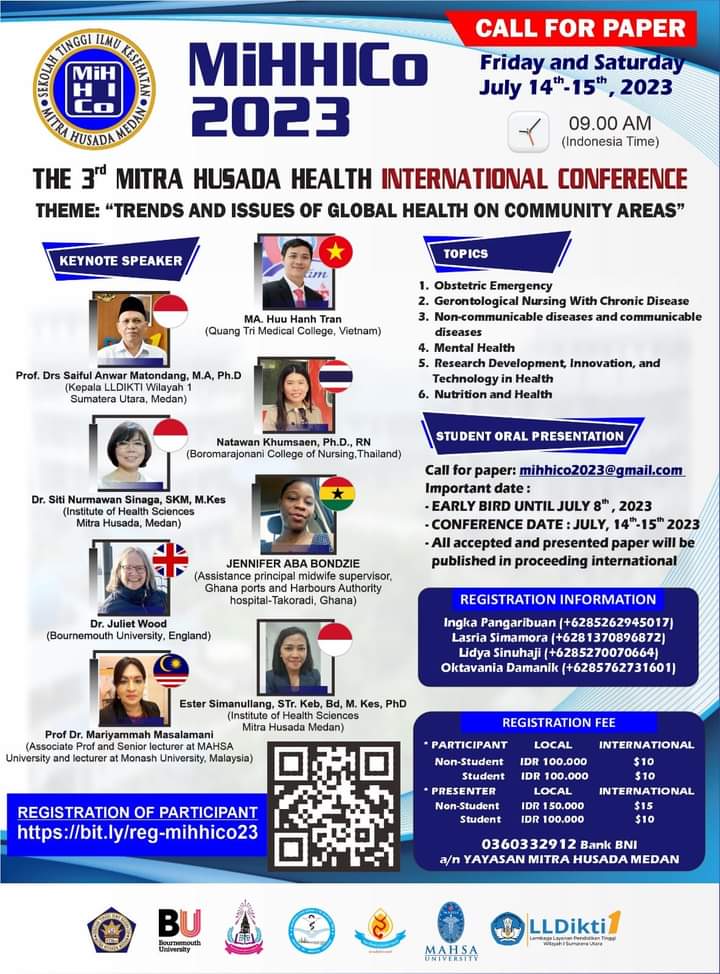FACTORS THAT INFLUENCE COUPLES OF FERTILE AGE IN THE USE OF IUD CONTRACEPTION DEVICES IN TITI RANTAI VILLAGE, MEDAN BARU DISTRICT IN 2022
Keywords:
Keywords: Couples of Reproductive Age, IUD Contraceptive Devices Keywords: Couples of Reproductive Age, IUD Contraceptive DevicesAbstract
Background: The National Family Planning (KB) Movement is one of the main activities in an effort to achieve quality families which is directed at controlling the rate of population growth by reducing the birth rate to achieve a balance between population growth and economic growth so as to improve family health
Research Objectives: To Analyze Factors Affecting Couples of Reproductive Age in Using IUD Contraceptive Devices in Titi Chain Village, Medan Baru District in 2022.
Method: This type of research is an analytical descriptive study with a cross-sectional design and a quantitative approach which is a study that studies the relationship between the independent variable (power) and the dependent variable (effect). The sample is 43 people.
Results: The results of the study showed that there was a significant relationship between education, employment, and the number of children with the use of IUD contraception in the Titi Chain Village, Medan Baru District, in 2022, with a p value <0.005.
Conclusion: The family planning program guarantees that every person or couple has access to family planning information and services so they can plan the right time for pregnancies, the spacing of pregnancies and the number of children.
References
Prevalensi Pemakaian Kontrasepsi. BPS. Jakarta
BKKBN, 2018. Target Peserta KB Sumut 2009 Sebanyak 332.161. Akseptor. http://sumut.bkkbn.go.id/news detail.php?nid=105.
Hartini, L. (2019). Hubungan Pendidikan dan Pekerjaan Ibu dengan Pemakaian Alat Kontrasepsi Dalam Rahim (AKDR). Jurnal Kesmas Asclepius, 1(2), 126-135.
Hutauruk, A., 2018. Hubungan Karakteristik Wanita Usia Subur (WUS) dan Kualitas Pelayanan KB di Kabupaten Tapanuli Tengah Tahun 2018 : Tesis Program Pasca Sarjana Magister Ilmu Kesehatan Masyarakat. Universitas Sumatera Utara. Medan.
Imroni, T.O., 2011. Bunga Rampai Sosiologi Keluarga. Yayasan Obor Indonesia. Jakarta.
Juliantoro, D, 2015. 30 Tahun Cakup KB dan Hak Konsumen. Sinar Harapan. Yogyakarta.
Kemenkes RI. 2018. Profil Kesehatan Indonesia Tahun 2018. Kementerian Kesehatan Republik Indonesia. Jakarta
Manuaba, I.B.G, 2017. Ilmu Kebidanan, Penyakit Kandungan dan KB. EGC. Jakarta.
Murti, B, 2007. Prinsip dan Metode Riset Epidemiologi. Cetakan Pertama Edisi Pertama. Gadjah Mada University Press. Yogyakarta.
Mutiara, Hanim. 2018. Faktor-Faktor Yang Mempengaruhi Pemakaian Alat Kontrasepsi Pada Istri PUS di Kecamatan Rambah Samo Kabupaten Rokan Hulu Tahun 2018: Tesis Program Pasca Sarjana Magister Ilmu Kesehatan Masyarakat. Universitas Sumatera Utara. Medan.
Notoatmodjo, Soekidjo. 2014. Promosi Kesehatan Teori dan Aplikasi. Rineka Cipta,Jakarta.
Setya Arum, Dyahnovita. Sujiyatini, 2016. Panduan Lengkap Pelayanan KB Terkini. Mitra Cendikia. Yogyakarta.
Siswosudarmo, HR. Dkk, 2017. Teknologi Kontrasepsi. Gadjah Mada University Press. Yogyakarta.
Survey Demografi Kesehatan Indonesia (SDKI). 2017. Survey Demografi Kesehatan Indonesia (SDKI) Tahun 2017. Kemenkes RI. Jakarta
Tripertiwi, S. (2019). Hubungan Status Pekerjaan Ibu dengan Minat Ibu dalam Menggunakan Kontrasepsi IUD di Puskesmas Bengkuring Kota Samarinda Tahun 2019.
Viviroy, 2018. Pengetahuan Sikap dan Perilaku Ibu-Ibu Akseptor KB Mengenai AKDR Serta Faktor-Faktor Yang Berhubungan di RW03 Kelurahan Tanju. http//:one.indoskripsi.com/node/5212.
Wiknjosastro, Hanifa. Dkk., 2013. Ilmu Kebidanan. Yayasan Bina Pustaka Sarwono Prawirokardjo. Jakarta.
Wiknjosastro, Hanifa. Dkk., 2012. Ilmu Kandungan. Edisi Ketiga Cetakan Keempat, Yayasan Bina Pustaka Sarwono Prawirokardjo. Jakarta.
Ibrahim, W. W., Misar, Y., & Zakaria, F. (2019). Hubungan Usia, Pendidikan Dan Paritas Dengan Penggunaan Akdr Di Puskesmas Doloduo Kabupaten Bolaang Mongondow. Akademika, 8(1), 35-44.







